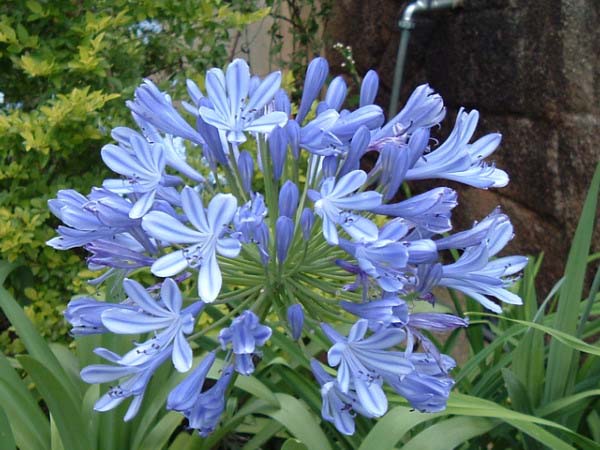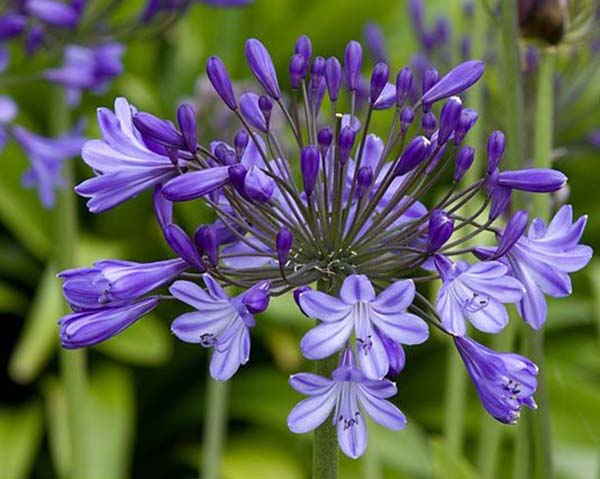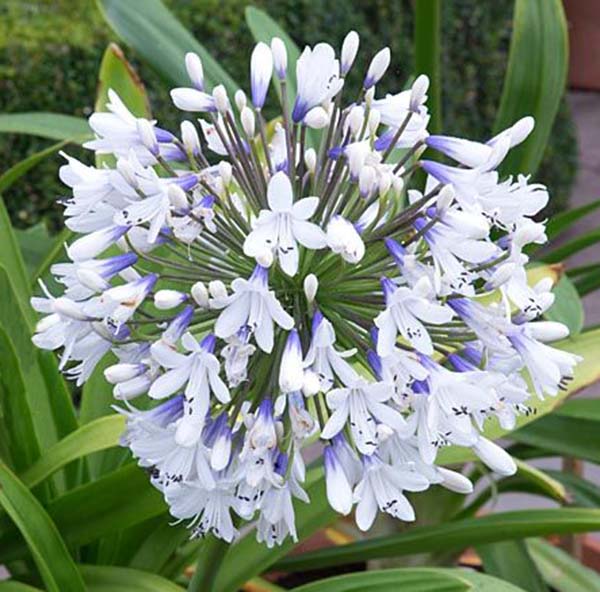Agapanthus: Beauty of the African Lily in Your Home
Agapanthus, or the African Lily, is an enchanting indoor plant that captivates with its elegant flowers and leaves. Originating from South Africa, this plant beautifully decorates interiors with its refined beauty.

Agapanthus (Agapanthus) is a genus of perennial herbs in the Amaryllis family. In the wild, it grows in South Africa from the Cape Province to Limpopo. Some species of agapanthus are also known as Nile lilies or African lilies.
Agapanthus plants are perennial herbaceous plants with fleshy rhizomes. The leaves are dense, strap-shaped, forming a basal rosette.
During flowering, agapanthus produces a long flower stem that can reach a height of 1 meter. The flowers of this plant are gathered in large umbellate inflorescences, colored in white, blue, or purple-blue.
Many hybrids and cultivated varieties are now acclimatized worldwide. All agapanthuses available in the market are commonly referred to as African agapanthus or African lilies. However, this is not entirely accurate. In fact, the name Agapanthus africanus has long been incorrectly applied to another species - Agapanthus praecox - in gardening purposes and publications worldwide, and the garden and indoor plants are actually hybrids or varieties of Agapanthus praecox.

The Most Well-Known Species of Agapanthus
- Agapanthus africanus: Flowering plant from the Agapanthus genus, found only in South Africa. Its leathery leaves are upright, long, and strap-shaped. The funnel-shaped flowers range from pale blue to dark blue, with a dark blue stripe running through the center of each petal. The flowers grow in large clusters, each flower being 25–40 mm long. This species typically blooms from November to April in the wild, usually after fires, which are common in that area.
- Agapanthus praecox: A perennial plant that can live up to 75 years, found in the Eastern Cape Province of South Africa. Its evergreen leaves are 2 cm wide and 50 cm long. The flowers are clustered in an umbel, with colors ranging from blue, violet, to white, blooming from late spring to summer. The flowering stem reaches a height of one meter. Most cultivated plants of the Agapanthus genus are hybrids or varieties of this species.

Tips for Caring for Agapanthus
Agapanthus is an easy-to-care-for indoor plant. Taking care of this plant won't consume too much of your time and energy. It is quite undemanding, rarely gets sick, and adapts well.
Light: Proper lighting is a key factor in caring for agapanthus. It is a light-loving plant that thrives in bright light but cannot tolerate direct sunlight in the hot midday. Place it in a room with diffused light or on an east-facing window to provide optimal growth conditions. Experts recommend moving the pot with the plant outdoors or onto an open balcony during the warm season.
Temperature: Agapanthus is tolerant of different temperature regimes but prefers moderate warmth. Maintain a temperature range of 65-80°F/18-27°C in the summer and allow the plant to rest at 50-59°F/10-15°C in winter.

Air Humidity: African lilies are quite tolerant of humidity and do not require additional moisture.
Water: Moderate watering is the key to the health of agapanthus. Let the soil dry between waterings, avoiding excess moisture. Water more frequently in the summer and reduce the amount of water in winter. Use soft water to prevent spots on the leaves.
Soil: Agapanthus requires light and fertile soil with good drainage. Use a mixture for indoor plants with added perlite or vermiculite to ensure proper root ventilation.
Fertilization: During the active growth period (spring-summer), fertilize agapanthus once a month with universal liquid fertilizer for indoor plants. Limit fertilization in the winter when the plant is dormant.

Repotting: Agapanthus does not like repotting. Repot every 2-3 years in the spring, renewing the soil and removing old roots. Choose pots slightly larger so that the plant can develop freely. It's good to know that taking too large a pot is undesirable - the African lily will bloom abundantly only when its rhizome is snug.
Dormancy Period: To prepare agapanthus for the dormant period, it is better to place it in a cool place. During wintering, the plant does not require close attention; occasional moistening is sufficient. African lilies in home conditions usually do not shed leaves, but their growth slows down or stops altogether.

If the bush grew in your garden during the summer, dig it up with a clod of soil, place it in a wooden box, and put it in the basement.
Agapanthus successfully overwinters in the garden where winters are mild. However, it must be covered with a cardboard box or fabric and mulched with withered leaves.
Propagation: Agapanthus can be propagated by dividing the clump or by seeds. Hybrids do not propagate by seeds. It is best to divide the clump during transplanting.
By following these simple recommendations, you can enjoy the splendor of agapanthus in your home, creating a cozy corner of nature and sophistication.





